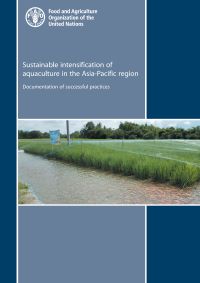The role of the private sector in sustainable aquaculture
4 March 2013 | Dan Fegan | 4543 views | .mp4 | 37.66 MB | Environment and Sustainability
Cargill, founded by William Wallace Cargill in 1865, has grown from a single grain elevator in Conover, Iowa to a highly diversified, privately-held global business composed of 71 businesses organized around four major segments: Agriculture, Food, Financial, and Industrial. Today Cargill has 139 000 employees in 65 countries.
As a global food and agricultural company, sustainability is critical to Cargill’s businesses, and we are involved in a range of stewardship activities to support responsible use of natural resources. Our innovative approaches to conserve resources, use renewable raw materials and reduce impacts are aimed at helping to protect and preserve our environment. Examples include our support for the Palm Oil Round Table and Responsible Soy Initiative, in collaboration with a variety of partners such as WWF, The Nature Conservancy, Global Aquaculture Alliance (GAA), the Aquaculture Stewardship Council (ASC) and the Sustainable Fisheries Partnership (SFP).
Aquaculture is a dynamic industry, and Cargill participates along the entire supply chain, supplying inputs, finance, technical support and information services. Cargill Animal Nutrition is at the heart of the supply chain and works hand-in-hand with many other Cargill businesses. For example, we often work with our grain and oilseeds businesses in sourcing raw materials, and with our animal protein businesses to develop technology and industry best practices. We also work with our processing businesses to identify co-products and additives that can be applied to the animal nutrition space. Our most significant challenge is how to deliver appropriate nutrition to meet expected performance at an affordable price?
Designing successful aquafeeds is a complex task requiring consideration of a wide range of factors aside from nutritional factors. Successful feed formulation depends on the needs of the species, the needs of the market, non-nutrition needs (such as price, pellet quality, color, smell, aggressive feed intake), nutritional profile, effective use of ingredients, technological, regulatory and cost constraints, and maintenance of high quality standards.
With the ratio of world feed grain stocks to use at a 38-year low, and unprecedented volatility in feed ingredient prices, the stakes have never been higher, and with increasing sophistication in buyer demand, aqua feed formulation is certainly an ongoing challenge. When choosing feeds, farmers typically present a number of buying signals. First, there is a prevailing popular belief that high crude protein (CP) is a guarantor of high quality, whilst in fact, nutritional value is driven by digestible amino acids and amino acid balance present in the formulation. With regulations specifying minimum CP levels, use of cheap or indigestible protein or non-protein nitrogen to satisfy CP expectations is growing.
Second, farmers want the feed to smell or taste fishy, even for herbivores and omnivores, requiring the incorporation of fishmeal or fish oil. Similarly, pellet colour is important, with markets varying in their preferences for pellet colour (dark or light). These two factors constrain ingredient and formulation choices.
A third factor is that farmers like to see fish fighting for feed, since this suggests a strong preference for a particular feed. Removing or reducing fishmeal reduces this behaviour, and additives have limited success or are too expensive. Adoption of alternative ingredients is constrained by one of more of these factors: Impacts on feed quality (appearance, smell, taste, water stability, fines); impacts on feed function (attractability, palatability, acceptability); and impacts on nutrient availability (digestibility, nutrient imbalance, anti-nutritional factors).
Intensification of aquaculture will be driven by a combination of technological, market and economic factors. Sustainability is an especially important consideration in aquaculture investment, in particular where external financing is required. Sustainability standards and certification provide reassurance for investors but these tend to apply mainly to exported products. Establishment of national regulatory mechanisms is fundamental to underpin and manage sustainable intensification, but needs to be carefully understood in order to avoid unintended consequences.
Intensification and sustainability are not mutually exclusive but can be developed as a “win-win” strategy. The challenge will be how to structure aquaculture development to allow adequate investment and economies of scale with appropriate safeguards of sustainability and food safety within a smallholder-based industry.
Creative Commons Attribution.
